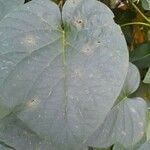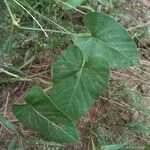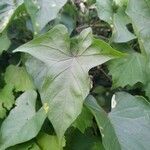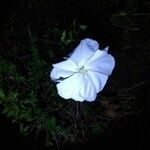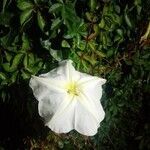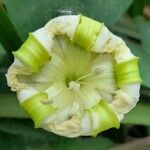Herbs annual or perennial, twining, usually glabrous, rarely puberulent. Stems to 10 m, terete, smooth or with soft prickles, sap milky. Petiole 5-20 cm; leaf blade ovate to ± circular in outline, 10-20 X 5-16 cm, base cordate, margin entire, angular to 3-lobed, apex acuminate, mucronulate. Inflorescences helicoid cymes, rarely dichasial, 1-to several flowered; peduncle stout, terete, 1-24 cm; bracts early deciduous, small. Pedicel 7-15 cm, clavate distally, enlarged in fruit. Flowers nocturnal, fragrant. Sepals elliptic to ovate, ± leathery, glabrous; outer 3 sepals 5-12 mm, apex with a stout spreading awn 4-9 mm; inner 2 sepals 7-15 mm, mucronate. Corolla white, with greenish bands, salverform; tube 7-12 cm, ca. 5 mm in diam.; limb 7-12 cm in diam., shallowly 5-undulate. Stamens exserted; filaments inserted in apical 1/2 of corolla tube, glabrous; anthers sagittate basally. Pistil exserted; ovary narrowly conical, glabrous. Stigma 2-lobed. Capsule ovoid, 2.5-3 cm, apiculate. Seeds white, brown, or black, ca. 10 7-8 mm, glabrous. 2n = 28*, 30*, 38*.
A glabrous or very rarely pubescent, annual or perennial; stems prostrate or twining, up to 2.4 m. long, smooth or rarely muriculate.. Leaf-blade ovate or orbicular in outline, entire or 3-lobed, 6–20 cm. long, 5–16 cm. wide, acute, acuminate or obtuse at the mucronulate apex, cordate at the base; petiole 5–20 cm. long.. Inflorescences axillary, 1–several-flowered; peduncle stout, 1–24 cm. long; pedicels 0.7–1.5 cm. long, lengthening to 2.5–3 cm. long and becoming very thick in fruit.. Sepals elliptic, unequal; outer 2–3 sepals 5–12 mm. long, 6–7 mm. wide, with a long awn-like appendage 4–10 mm. long at the apex (Fig. 22/4, p. 102); inner sepals longer, 8–15 mm. long, 9 mm. wide, shortly mucronulate.. Corolla opening at night, scented, white or greenish-cream below; tube cylindrical, 7–12 cm. long, 5 mm. wide; limb salver-shaped, 11–16 cm. wide.. Capsule ovoid, 2.5–3 cm. tall, glabrous.. Seeds 4, ovoid, white to black, glabrous, 10–12 mm. long, 7–9 mm. wide.
Herbaceous annual or perennial, usually glabrous. Stems prostrate or twining, laticiferous, smooth or sometimes muriculate, up to 5 m long. Leaves oblong to orbicular in outline, 60-120 x 50-160 mm, entire or 3-lobed, apex acuminate, mucronulate, base cordate, basal auricles rounded to angular, margin entire; petiole 50-200 mm long. Inflorescence axillary, 1-several-flowered; peduncle stout, 10-240 mm long; bracteoles small; pedicels up to 30 mm long and very thick in fruit. Sepals unequal, elliptic; outer ones 5-10 mm long with a long awn-like appendage; inner ones 8-15 mm long, shortly mucronulate. Corolla salver-shaped, opening at night, fragrant, white, greenish cream-coloured below; tube 70-150 mm long, cylindrical; limb 110-160 mm wide. Capsule ovoid, mucronate, glabrous, 25-30 mm long. Seeds 4, ovoid, 10-12 mm long, white, brown or black, glabrous, smooth. Flowering time throughout the year, mostly January and February.
Glabrous, fibrous-rooted perennial. Stems twining, sometimes muricate. Petiole 2.5-3.8 cm long. Lamina 5.5-16 × 4-14 cm, broad-ovate, entire or with 2 small outwardly directed lobes towards the base, deeply cordate with ± rounded sinus; apex usually acuminate. Infl. axillary, cymose, 1-few-flowered; peduncles stout; pedicels to 1 cm long, stout. Bracts small, caducous. Sepals 1.7-2 cm long, elliptic, unequal; outer 2 or 3 sepals with long patent or curved awns, the inner at most mucronate. Corolla 9.5-11 cm diam. across the patent limb, white with green mid-petaline bands outside, salverform; tube narrow-cylindric, 8.25-9.5 cm long. Stamens with exserted part 1.5-2.5 cm long; filaments glabrous. Capsule 2.5-3 cm long, ovoid, prominently beaked. Seeds c. 10 × 7 mm, deep brown, glabrous.
Vines; stems herbaceous at the tips, becoming woody at the base, smooth or often with short fleshy prickles, occasionally rooting near the nodes, glabrous. Leaves rounded ovate, entire or 3-5-lobed, 5-15 cm long, basally cordate, apically acuminate, glabrous. Flowers in 1-to several-flowered cymes, inflorescences and peduncles glabrous; sepals fleshy, ovate to elliptic, 10-20 mm long, apically a A recently observed fruiting collection from Venezuela shows that I. squiamosa is indeed a member of the Eriospermum group.
A twining plant which keeps growing from year to year. It can climb to 5 m high and spread to 20 m across. It is often grown as an annual plant. The leaves are oval or rounded and sometimes with 3 lobes. They are deep green in colour. Leaves are 10-20 cm long. The flowers are trumpet shaped and occur as 1-8 together. They are 12-14 cm across and tinted green on the outside. They have a sweet smell and open at night.
caudate at least on the outer sepals; corolla white with greenish nectar-guides, the tube 9-15 cm long, the rotate limb 8-10 cm broad. Fruits capsular, ovoid to subglobose, 2-3 cm long, 1-2 cm in diameter, with a 7-10 mm apiculus, mostly dark brown, glabrous; seeds dark brown to black, 8-10 mm long, glabrous.
Twining or prostrate annual or perennial herb. Leaves ovate or circular in outline, entire or 3-lobed. Inflorescence 1-several-flowered. Sepals distinctly awned. Corolla tube 70-120 mm long. Seeds glabrous. Flowers white or greenish cream below, opening at night.
Sepals unequal, elliptic, coriaceous, often reflexed in fruit and glabrous; outer 2–3 sepals 5–12 mm. long with long awn-like appendage 4–10 mm. long at the apex; inner ones longer, 8–15 mm. long, shortly mucronulate.
Leaf-lamina ovate or circular, in outline, entire or 3-lobed, 6–20 × 5–16 cm., acute, acuminate or obtuse at the mucronulate apex, cordate at the base; petiole 5–20 cm. long, slender.
Inflorescence axillary, 1-several-flowered; peduncle stout, 1–24 cm. long; pedicels 0·7–1·5 cm. long, lengthening to 2·5–3 cm. long and becoming very thick and clavate in fruit.
Corolla opening at night, scented, white or greenish-cream below; tube cylindrical 7–12 × 0·5 cm.; limb salver-shaped, 11–16 cm. wide.
Ornamental species, annual or perennial, glabrous or rarely pubescent.
Large white flowers 4-6 in. across the limb, exping fragrant at night
Stems twining or prostrate, thick, smooth or rarely muriculate.
A strong twiner with stems smooth or sparingly tuberculed
Seeds 4, ovoid, brown or black, glabrous and smooth.
Capsule mucronulate 2·5–3 cm. long, glabrous.
